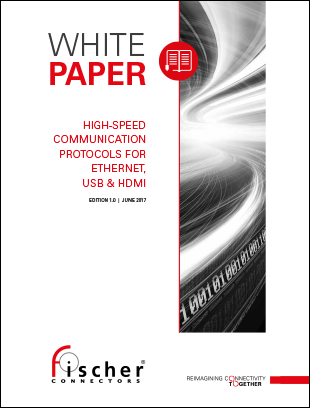With the rise of Industry 4.0, wearables, and new technologies in the defense and medical industries, today’s engineers are not only challenged to get all the necessary data transferred, but to figure out how fast we can get the massive amounts of data to move as well. Wired connections still transport more data faster than wireless, so the hunt for faster data transmission without interference continues to drive innovation in connectors, traditional copper cabling, and fiber optics.
Three things to consider when you have a need for data speed
July 23, 2020 · 3 LesezeitIn his article published in ConnectorSupplier’s ‘2020 Data Connectivity eBook’, Hassan Fadli, Head of Product Design at Fischer Connectors, describes three things to consider when you have a need for data speed:
- Connector Design and Selection. Designing a connectivity solution for a specific data protocol requires optimizing the design of both the connector and the cable. While they have to work properly together, the first condition for a functional solution is to have a connector that is capable of handling a specific protocol or multiple high-speed protocols. The protocol or protocols used will determine the number of contacts for each connector.
- Cable Design and Selection. You have to look beyond the connector and its configuration to achieve a certain data speed. The construction of the cable itself plays a huge role in determining whether a connectivity solution will meet high-speed data requirements (cf. ISO/IEC 11801 for cable categories and cable shielding, which also plays a role in data speed).
- Simulation and Testing. Once a connector and cable have been designed and optimized for a defined protocol, a physical product prototype needs to be tested to validate the full characterization using a network analyzer. It’s not outside the realm of possibility for a connector and a cable to each separately pass a speed test but then fail when put together, so it’s crucial to test the full assembly.
Read the full article by Hassan Fadli in the ‘2020 Data Connectivity eBook’ (pp. 18-21): Three Things to Consider When you Have a Need for Data Speed.
The product features of four of our connector product lines are on page 67 of the eBook:
- The Fischer MiniMax™ Series delivers high-speed performance in ruggedized, miniature USB 2.0/3.0, Ethernet, and HDMI configurations with 4-24 contacts, 360° EMC shielding, IP68 sealing (20m/24hrs/mated/unmated), and three locking systems. It’s rated for >5,000 mating cycles and up to 135 °C and can be pre-cabled and customized.
- Fischer UltiMate™ Series push-pull connectors and assemblies deliver power and high-speed signal in harsh environments. They are small, rugged, lightweight, highly configurable, fully shielded, robustly keyed, sealed to IP68/69 (120m/24hrs/mated/unmated) and rated for up to 26A/pin, -55 °C to 135 °C, and >10,000 mating cycles.
- Fischer FiberOptic Series connectors and cable assemblies enable high-speed, high-volume data transfer and optimal single- and multimode optical butt-joint performance. They’re field-cleanable, sealed to Ip67/68 (unmated/mated), and ruggedized for harsh environments and available with 1-4 optical channels or as 2+2 copper hybrid.
- The Fischer Freedom™ Series’ Fischer LP360™ range of versatile, keyless, membrane-sealed, fully cleanable, plug-and-play connectivity solutions includes connectors, cable assemblies, and active devices with 360° mating freedom to maximize usability, efficiency, and performance and optimize cable management over long lifetimes.
Also read our white paper ‘High-Speed Communication Protocols for Ethernet, USB and HDMI’ to get an overview of the most relevant parameters that determine whether a connector cable assembly can withstand a defined data protocol. The white paper also shows the performances of the Fischer MiniMax™ & Fischer UltiMate™ cabled connectors according to the most popular data protocols.
Interested in this topic?
More details in our white paper “High-Speed Communication Protocols for Ethernet, USB and HDMI”
This may be of interest to you
Fischer LP360™, der ideale Steckverbinder für die Magnetometer von SENSYS
July 10, 2020 · Lesezeit 4 min

